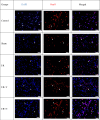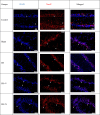Effect of 2-Week Naringin Supplementation on Neurogenesis and BDNF Levels in Ischemia-Reperfusion Model of Rats
- PMID: 38457013
- PMCID: PMC10924031
- DOI: 10.1007/s12017-023-08771-0
Effect of 2-Week Naringin Supplementation on Neurogenesis and BDNF Levels in Ischemia-Reperfusion Model of Rats
Abstract
Background: Ischemic stroke is the leading cause of mortality and disability worldwide with more than half of survivors living with serious neurological sequelae; thus, it has recently attracted a lot of attention in the field of medical study.
Purpose: The aim of this study was to determine the effect of naringin supplementation on neurogenesis and brain-derived neurotrophic factor (BDNF) levels in the brain in experimental brain ischemia-reperfusion.
Study design: The research was carried out on 40 male Wistar-type rats (10-12 weeks old) obtained from the Experimental Animals Research and Application Center of Selçuk University. Experimental groups were as follows: (1) Control group, (2) Sham group, (3) Brain ischemia-reperfusion group, (4) Brain ischemia-reperfusion + vehicle group (administered for 14 days), and (5) Brain ischemia-reperfusion + Naringin group (100 mg/kg/day administered for 14 days).
Methods: In the ischemia-reperfusion groups, global ischemia was performed in the brain by ligation of the right and left carotid arteries for 30 min. Naringin was administered to experimental animals by intragastric route for 14 days following reperfusion. The training phase of the rotarod test was started 4 days before ischemia-reperfusion, and the test phase together with neurological scoring was performed the day before and 1, 7, and 14 days after the operation. At the end of the experiment, animals were sacrificed, and then hippocampus and frontal cortex tissues were taken from the brain. Double cortin marker (DCX), neuronal nuclear antigen marker (NeuN), and BDNF were evaluated in hippocampus and frontal cortex tissues by Real-Time qPCR analysis and immunohistochemistry methods.
Results: While ischemia-reperfusion increased the neurological score values, DCX, NeuN, and BDNF levels decreased significantly after ischemia in the hippocampus and frontal cortex tissues. However, naringin supplementation restored the deterioration to a certain extent.
Conclusion: The results of the study show that 2 weeks of naringin supplementation may have protective effects on impaired neurogenesis and BDNF levels after brain ischemia and reperfusion in rats.
Keywords: BDNF; DCX; Flavonoid; Naringin; NeuN; Neurogenesis.
© 2024. The Author(s).
Conflict of interest statement
The authors declare no competing interests.
Figures











Similar articles
-
Effect of 2 Weeks Naringin Application on Neurological Function and Neurogenesis After Brain Ischemia-Reperfusion in Ovariectomized Rats.Mol Neurobiol. 2025 Sep;62(9):12106-12124. doi: 10.1007/s12035-025-05050-w. Epub 2025 May 15. Mol Neurobiol. 2025. PMID: 40374843 Free PMC article.
-
Naringin Affects Caspase-3, IL-1β, and HIF-1α Levels in Experimental Kidney Ischemia-Reperfusion in Rats.Curr Pharm Des. 2024;30(42):3339-3349. doi: 10.2174/0113816128324562240816095551. Curr Pharm Des. 2024. PMID: 39229980
-
Dexmedetomidine Stereotaxic Injection Alleviates Neuronal Loss Following Bilateral Common Carotid Artery Occlusion via Up-Regulation of BDNF Expression.In Vivo. 2024 Jan-Feb;38(1):184-189. doi: 10.21873/invivo.13424. In Vivo. 2024. PMID: 38148065 Free PMC article.
-
Huatuo Zaizao pill promotes functional recovery and neurogenesis after cerebral ischemia-reperfusion in rats.BMC Complement Altern Med. 2017 Jan 5;17(1):19. doi: 10.1186/s12906-016-1516-z. BMC Complement Altern Med. 2017. PMID: 28056920 Free PMC article.
-
The impact of flavonoids and BDNF on neurogenic process in various physiological/pathological conditions including ischemic insults: a narrative review.Nutr Neurosci. 2024 Sep;27(9):1025-1041. doi: 10.1080/1028415X.2023.2296165. Epub 2023 Dec 27. Nutr Neurosci. 2024. PMID: 38151886 Review.
Cited by
-
Effect of 2 Weeks Naringin Application on Neurological Function and Neurogenesis After Brain Ischemia-Reperfusion in Ovariectomized Rats.Mol Neurobiol. 2025 Sep;62(9):12106-12124. doi: 10.1007/s12035-025-05050-w. Epub 2025 May 15. Mol Neurobiol. 2025. PMID: 40374843 Free PMC article.
-
The Effect of Naringin on Cognitive-Behavioral Functions, CREB/BDNF Signaling, Cholinergic Activity, and Neuronal Density in the Hippocampus of an MSG-Induced Obesity Rat Model.Neurotox Res. 2025 Feb 28;43(2):11. doi: 10.1007/s12640-025-00733-7. Neurotox Res. 2025. PMID: 40016546
-
Potential of Natural Phenolic Compounds against Doxorubicin-Induced Chemobrain: Biological and Molecular Mechanisms Involved.Antioxidants (Basel). 2024 Apr 18;13(4):486. doi: 10.3390/antiox13040486. Antioxidants (Basel). 2024. PMID: 38671933 Free PMC article. Review.
-
Sex- and subregion-specific vulnerability of the hippocampus and amygdala to intermittent hypoxia in relation to learning/memory function and anxiety tendencies of infant rats.Sleep Breath. 2025 Jun 9;29(3):209. doi: 10.1007/s11325-025-03382-4. Sleep Breath. 2025. PMID: 40490588 Free PMC article.
-
3',4'-Dihydroxy Flavonol (DiOHF) Exerting a Positive Effect on Neurogenesis and Retinal Damage in Experimental Brain Ischemia-Reperfusion of Rats.Curr Pharm Des. 2025;31(23):1877-1884. doi: 10.2174/0113816128360698250103082923. Curr Pharm Des. 2025. PMID: 39865828
References
-
- Prabhakaran, S., Ruff, I., & Bernstein, R. A. (2015). Acute stroke intervention: A systematic review. JAMA,313, 1451–1462. - PubMed
-
- Marques, B. L., Carvalho, G. A., Freitas, E. M. M., Chiareli, R. A., Barbosa, T. G., Di Araujo, A. G. P., Nogueira, Y. L., Ribeiro, R. I., Parreira, R. C., Vieira, M. S., Resende, R. R., Gomez, R. S., Oliveira-Lima, O. C., & Pinto, M. C. X. (2019). The role of neurogenesis in neurorepair after ischemic stroke. Seminars in Cell & Developmental Biology,95, 98–110. - PubMed
MeSH terms
Substances
LinkOut - more resources
Full Text Sources

